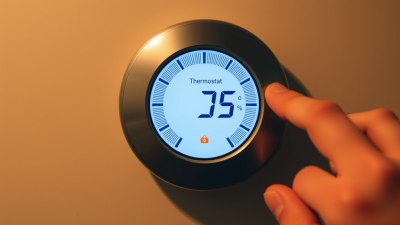Why You Can’t Nail Deadlines Without a Reliable Thermostat
Discover how a reliable thermostat impacts workplace productivity and why it’s essential for meeting deadlines efficiently.

Image created with Flux Schnell
When it comes to meeting deadlines, many factors come into play—from effective time management and team coordination to resource availability and technical infrastructure. However, one often overlooked element that significantly affects productivity and the ability to meet deadlines is the ambient environment, particularly temperature control managed through a reliable thermostat. Although this might sound far removed from the realm of project timelines and deliverables, the truth is that a consistent, comfortable workspace temperature can make or break your ability to efficiently hit deadlines.
The Link Between Temperature and Productivity
Numerous scientific studies have explored the relationship between ambient temperature and human performance. According to research from institutions such as Cornell University and the Lawrence Berkeley National Laboratory, workplace temperature directly influences workers’ comfort, focus, cognitive function, and overall productivity. When employees feel too hot or too cold, their productivity tends to plummet.
For instance, workers in cold environments often struggle with cognitive tasks due to diminished blood flow to extremities and discomfort that distracts from their focus. Conversely, overly warm workspaces can increase fatigue, reduce concentration, and elevate stress levels. Each of these factors contributes to lower efficiency and an increased likelihood of missing project deadlines.
The Critical Role of a Reliable Thermostat
To maintain an optimal environment, it’s not enough to merely have a heating or cooling system. It’s essential that these systems are governed by a reliable thermostat capable of precise temperature regulation. An unreliable thermostat—one that constantly fluctuates or misreads room temperature—can cause inconsistent environmental conditions that make it harder for employees to maintain focus.
A stable, well-regulated temperature fosters comfort and reduces physical distractions, which lets people dedicate more mental resources toward managing tasks and problem-solving. In this context, a dependable thermostat acts as an unsung hero, silently supporting your team’s ability to meet deadlines by stabilizing their work environment.
How Temperature Fluctuations Interrupt Workflows
Environmental instability due to faulty thermostats or poor temperature management often results in frequent interruptions. Imagine your office temperature rising unexpectedly in the middle of a critical work session, causing discomfort and the need to adjust clothing or seek breaks. Similarly, a sudden chill might lead to distractions as individuals try to stay warm. These interruptions can quickly add up, consuming time and breaking the mental flow necessary for efficient output.
Such disruptions often have cascading effects, delaying task completion, thwarting team collaboration, and, ultimately, causing deadlines to slip. When the temperature is kept consistently comfortable, employees are less prone to these distractions and better able to maintain an effective rhythm throughout their workday.
Temperature Control and Employee Health
Health is another key consideration linked to thermostat reliability. Poor temperature management can contribute to respiratory issues, dehydration, headaches, and increased stress, all of which negatively impact employee attendance and productivity. In extreme cases, malfunctioning HVAC systems can facilitate the spread of airborne illnesses.
By maintaining an environment where temperatures are stable and within a comfortable range, organizations reduce the risk of such health problems. Healthy employees invariably perform better and increase the likelihood that projects will proceed according to schedule.
Energy Efficiency Benefits of Reliable Thermostats
Besides helping meet deadlines through improved productivity, reliable thermostats contribute to energy efficiency, which indirectly supports project management objectives by reducing operational costs. Modern programmable and smart thermostats can optimize heating and cooling cycles to prevent energy waste while maintaining desired temperatures.
Effective energy management ensures operational budgets remain intact, allowing companies to allocate resources to critical areas like staffing or technology upgrades that improve workflow and deadline adherence. In contrast, outdated or faulty thermostats may cause energy inefficiencies leading to higher utility bills and strained finances, which can pressure project resources.
Case Study: Office Environment Improvement and Deadline Success
Consider a mid-sized marketing agency that frequently struggled to meet tight campaign deadlines. Feedback revealed widespread complaints about uncomfortable office temperatures, which fluctuated due to an aging HVAC system controlled by outdated thermostats. Employees reported difficulty maintaining concentration, resulting in prolonged task times and repeated errors.
By investing in reliable smart thermostats with remote monitoring, the company was able to maintain consistent temperatures tailored to employee preferences during work hours. This upgrade reduced complaints by over 70%, enhanced comfort, and boosted employee morale. Within months, productivity metrics improved significantly, and the agency met 95% of its project deadlines on time compared to 70% previously.
Choosing the Right Thermostat for Your Workplace
Selecting a reliable thermostat involves considering various factors, including accuracy, programmability, compatibility with your HVAC system, and ease of use. Modern choices range from simple programmable units to advanced smart thermostats integrated with IoT (Internet of Things) technologies that enable remote control, learning temperature patterns, and energy usage analytics.
Organizations aiming to improve deadline adherence through environmental optimization should prioritize thermostats that offer precise control and flexibility to adapt to varying occupancy levels and seasonal changes. Investing in quality equipment upfront typically yields returns through improved employee productivity and reduced energy waste.
Leveraging Technology for Smarter Temperature Management
Advances in technology now provide powerful tools for managing workplace environments dynamically. Smart thermostats equipped with sensors can detect occupancy and adjust temperatures accordingly, ensuring energy is not wasted when spaces are unoccupied but comfort is prioritized during work periods.
Furthermore, integration with building management systems allows facility managers to monitor multiple zones simultaneously, making timely adjustments that support ongoing projects. These capabilities help create an environment where teams can focus unhindered, thereby enhancing their ability to adhere to deadlines.
The Psychological Impact of Comfortable Environments
Beyond physical comfort, a stable temperature controlled by a reliable thermostat positively influences psychological well-being. Studies in environmental psychology confirm that comfortable thermal conditions reduce stress and anxiety, which are known factors that impair decision-making and memory. Stress-free employees exhibit greater creativity, better problem-solving skills, and resilience—qualities crucial for deadline-driven work settings.
When people feel they are cared for through attention to their environment, motivation naturally increases. This motivation helps teams push through challenging periods and complex tasks, reducing procrastination and preventing last-minute rushes that often jeopardize schedules.
Cost Implications of Ignoring Temperature Control
Failing to maintain reliable temperature regulation can lead to hidden costs. These include lower productivity, increased sick days, employee turnover due to dissatisfaction, and inefficient energy use. Such expenses can indirectly affect project budgets and timelines, jeopardizing deadlines.
Therefore, investing in proper thermostat technology is not merely an operational expense but a strategic move to safeguard deadline commitments and overall business health.
Actionable Tips to Enhance Temperature Reliability
To leverage temperature control for better deadline management, organizations should consider the following actions:
- Conduct an audit of existing HVAC and thermostat systems to identify shortcomings.
- Engage experts to recommend and install reliable, programmable, or smart thermostats suitable for the workplace.
- Train facility managers and relevant staff to use thermostat technology effectively.
- Gather employee feedback regularly to adjust temperature settings according to comfort needs.
- Monitor energy usage patterns to detect anomalies that indicate system malfunctions.
Implementing these measures creates a more stable environment that supports sustained focus and timely task completion.
The Broader Impact on Organizational Culture
Beyond immediate productivity gains, maintaining a comfortable workplace signals that an organization values employee well-being. This focus fosters a culture of care and respect that enhances engagement and collaboration. Engaged teams communicate more effectively, solve problems rapidly, and align better with organizational goals—all vital for meeting deadlines consistently.
Employees are more likely to stay loyal and invested in their work when their comfort is prioritized, reducing turnover and the disruption it causes to project timelines.
In summary, a reliable thermostat plays a pivotal role in creating an environment that fosters productivity, comfort, health, and energy efficiency—key components intertwined with successful deadline adherence. Unstable and uncomfortable temperatures lead to distractions, health issues, and low morale, all harmful to project timelines.
Investing in dependable thermostat technology and smart temperature management practices supports workforces in focusing fully on their tasks, preserving momentum, and delivering projects on schedule. Organizations that overlook this essential element risk suboptimal results despite robust planning and skilled teams.
By recognizing the connection between environmental comfort and deadline success, companies can transform their approach to project execution, ensuring deadlines are not just met but consistently surpassed.











